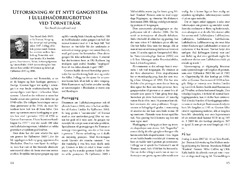Blar i forfatter Artikler, rapporter og annet (språk og kultur) "Brattli, Tore"
-
Antall grotter i Kaledonidene
Finnesand, Torstein; Brattli, Tore (Journal article; Tidsskriftartikkel, 2010)The article identifies the exponent for the longest caves in the Scandinavian Caledonides, UK, part of the Alps, USA and the earth. The exponent is used to calculate the total number of caves longer than 100 m and 10 m in different regions, using equations described by Rane Curl in 1986 and statistical methods like maximum likelihood estimation and Kolmogorov-Smirnov. The article discusses whether ... -
Oppdag ny kunnskap med WolframAlpha!
Brattli, Tore (Journal article; Tidsskriftartikkel, 2009) -
Recent Semantic Changes for the Term "Digital"
Brattli, Tore (Journal article; Tidsskriftartikkel; Peer reviewed, 2016)The term digital originates from the Latin word for finger/counting and has for many years been used to denote discrete signals and information, as opposed to analog. Discrete representation is an important principle, not only in computers, but also for (printed) text, music scores and even our genes. Recently however, the use of the term has increased and the meaning expanded to include almost ... -
Utforskning av et nytt gangsystem i Lullehačorrugrottan ved Torneträsk
Brattli, Tore (Journal article; Tidsskriftartikkel, 2007-06)The Lullehačorrugrottan cave in the Torneträsk area of northern Sweden was originally surveyed to 1145 m by Gunnar Rasmusson 50 years ago. Later surveys in 2003 added 267 m of new cave passages (grade 2). In March 2007 a Norwegian / Swedish joint expedition explored and partly surveyed the continuation of one of the passages discovered in 2003. The benefit of winter caving is low water level, because ... -
Why build Dewey numbers? The remediation of the Dewey Decimal Classification system
Brattli, Tore (Journal article; Tidsskriftartikkel; Peer reviewed, 2012)Correct Dewey classification is demanding and time consuming. Many of the challenges with the Dewey system are related to locating and interpreting notes (i.e. classification guidelines), and number building. Today’s Dewey structure is a result of more than 100 years of optimizing a comprehensive classification system to the printed book medium. In order to limit the system into a “manageable” size, ... -
Wolfram|Alpha – noen inntrykk etter første halvår
Brattli, Tore (Journal article; Tidsskriftartikkel, 2009)


 English
English norsk
norsk




